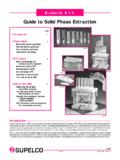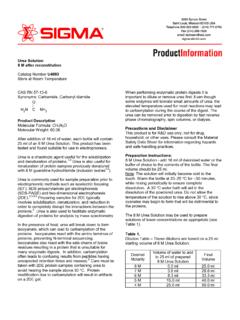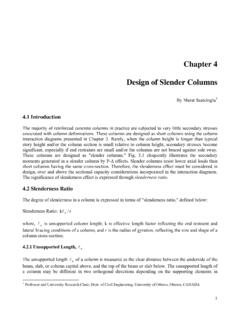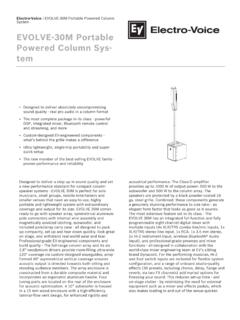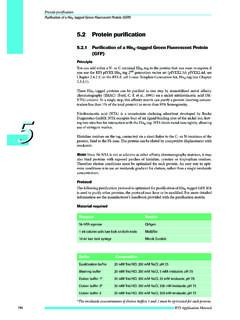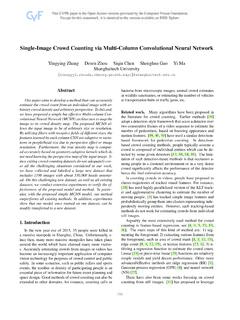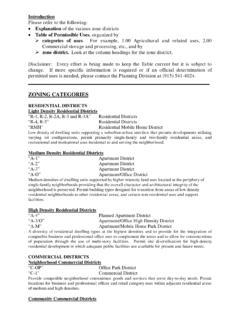Transcription of GC Column Selection Guide - Sigma-Aldrich
1 PerformanceReliabilityServiceAchieve Optimal Method PerformanceGC Column Selection Column Selection GuideSupelco began in 1966 in a tiny garage in a small central Pennsylvania (USA) town manufacturing packed gas chromatography (GC) columns . By 1977, glass capillary GC columns were being manufactured and in 1982, production began on fused silica capillary GC columns . In 1983, the first special purpose fused silica capillary GC Column was introduced. Since then, an impressive list of special purpose fused silica capillary GC columns has followed.
2 We test every capillary Column we manufacture according to strict quality assurance processes, and guarantee satisfactory Service chemists are a valuable resource for providing guidance with the Selection and use of capillary columns . Technical Service can be reached at 800-359-3041 (USA and Canada only), 814-359-3041, or at IntroducedSpecial Purpose Fused Silica Capillary GC Column1983SP -25601984 SPB -608, SUPELCOWAX 101985SP-23311986 VOCOL 1987 Sup-Herb , SP-23801988 Petrocol DH, Nukol 1989 Petrocol DH 150, Petrocol 28871990 Omegawax 320, Petrocol DH 250, SPB-1 SULFUR, Petrocol EX2887, Carbowax Amine1993 -DEX 120, -DEX 110, -DEX 120, SAC -5, TCEP1994 -DEX 120, OVI-G43, Carboxen -1006 PLOT, Mol Sieve 5A PLOT, Supel-Q PLOT, SCOT Columns1995 SPB-624, SPB-PUFA, Petrocol DH Octyl, SPB-Octyl.
3 PTA-51996 -DEX 225, -DEX 225, -DEX 225, -DEX 325, -DEX 325, -DEX 325, Omegawax 530, SPB-10001997 SPB-HAP, Carboxen-1010 PLOT2003 Equity -1701, Alumina chloride PLOT, Alumina sulfate PLOT2005 SLB -5ms2007 CHIRALDEX Column line, Omegawax 1002008 SLB-IL100, MET-Biodiesel2009 SLB-IL59, SLB-IL762010 SLB-IL61, SLB-IL82, SLB-IL1112012 SLB-IL60 The History of Supelco and the Capillary ColumnTable of Contents PageHow to Choose a Capillary Reading / Product Literature.
4 6 Column Phase Selection by Industry ..7 Column Phase Selection by Application ..14 Cross-Reference columns by Phase ..17 Traditional Chiral PLOT SCOT Numbers ..253 Order: 800-325-3010 ( ) 814-359-3441 (Global) How to Choose a Capillary ColumnAn optimized chromatographic separation begins with the Column . The Selection of the proper capillary Column for any application should be based on four significant factors: stationary phase, Column , film thickness, and Column length. The practical effects of these factors on the performance of the Column are discussed briefly in this section, in order of importance.
5 Note that this information is general. Specific situations may warrant exceptions to these 1 Stationary Phase Choosing a stationary phase is the most important step in selecting a Column . A stationary phase is the film coated on the inner wall of a capillary Column , and should be selected based on the application to be performed. The differences in the chemical and physical properties of injected organic compounds and their interactions with the stationary phase are the basis of the separation process. When the strength of the analyte-phase interactions differs significantly for two compounds, one is retained longer than the other.
6 How long they are retained in the Column (retention time) is a measure of these analyte-phase the chemical features of the stationary phase alters its physical properties. Two compounds that co-elute (do not separate) on a particular stationary phase might separate on another phase of a different chemistry, if the difference in the analyte-phase interactions is significant. This is the reason for providing a wide variety of capillary Column phases. Each phase provides a specific combination of interactions for each chemical class of Applications: Gas chromatography, first established in the 1950 s, is a mature analytical technique with many established applications.
7 Therefore, it is probable that literature, such as written methodology or journals, exists stating which stationary phases have successfully been used for a given application. Additionally, Column manufacturers routinely publish phase Selection charts, such as those on pages 7 15. Charts like these are conveniently arranged by industry to simplify the process of selecting the proper phase. First, find the chart that matches your industry or area of interest. Then, locate the application within that chart to identify a recommended Column Applications: For new applications, there is often no existing reference to provide guidance.
8 In these method development instances, one must have some knowledge of the chemistry of the compounds to be analyzed. Phase Selection is based on the general chemical principle that likes dissolves like. A non-polar Column is the recommended starting point for the analyses of non-polar compounds. Likewise, polar columns are usually recommended for the separation of polar compounds. The Phase Polarity insert (see below) describes several recommended phases for each group of compound PolarityThis is the single most important characteristic in selecting a capillary Column because it dictates selectivity, or the ability of the Column to separate sample components.
9 Phase Selection is based on the general chemical principle that likes dissolves like. A non-polar Column is best for the analyses of non-polar compounds. Polar columns most effectively separate polar compounds are generally composed only of carbon and hydrogen atoms and contain carbon-carbon single bonds. Non-polar capillary columns separate these compounds very well. Interaction between non-polar compounds and a non-polar phase are dispersive, meaning that they are governed by Van der Waals forces. These are intermolecular attractions that increase with the size of the compound.
10 Thus, larger compounds with higher boiling points have longer retention. Elution order generally follows the boiling points of the compounds are composed primarily of carbon and hydrogen atoms, but also contain one or more atoms of bromine, chlorine, fluorine, nitrogen, oxygen, phosphorus, or sulfur. Alcohols, amines, carboxylic acids, diols, esters, ethers, ketones, and thiols are typical polar compounds analyzed by capillary GC. Intermediate polar or polar capillary columns separate these compounds well. In addition to dispersive interactions, interactions between polar compounds and the phase include dipole, - , and/or acid-base interactions.

